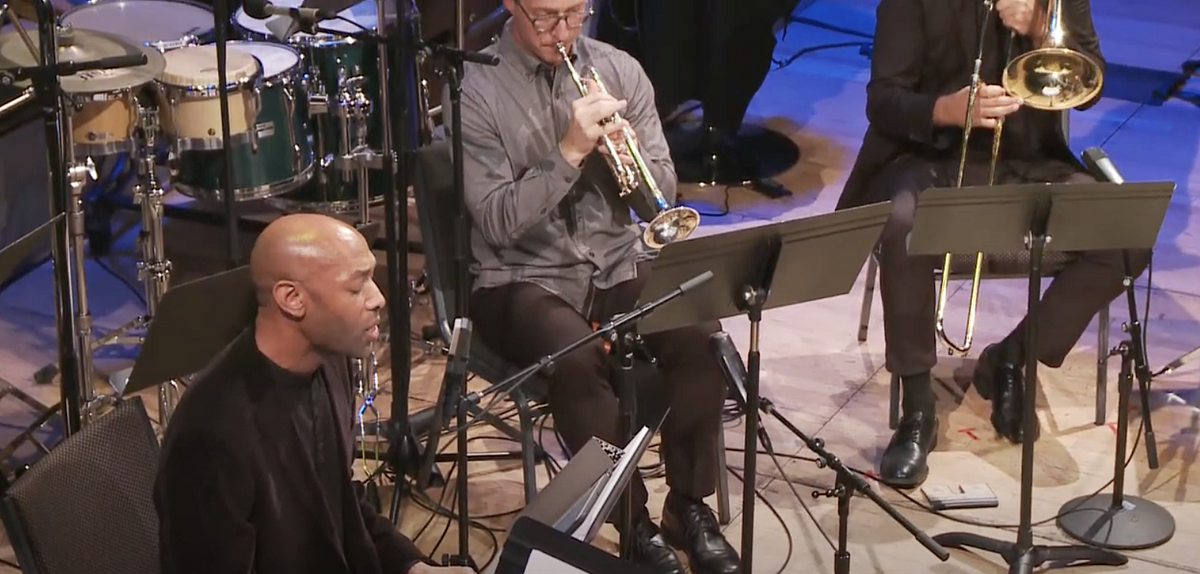NYC
The New Was Still Happening
by | Oct 6, 2023 4:52 pm
Post a Comment | E-mail the Author
Posted to: Music

Thursday night's performance.
George Lewis: Hearing Voices
Performed by the International Contemporary Ensemble
Roulette, Brooklyn
Oct. 5, 2023
“This seems to happen more and more during my pieces,” George Lewis said with good humor and palpable patience as violinist Josh Modney exited the stage. Modney’s G string snapped seconds into the opening section of Lewis’s Melodies for Miles, a piece for solo violin which murmurs with virtuosity and overheard birdsong.
Lewis shrugged the incident off with all the grace of someone who’s been making New Music for five decades straight.
I capitalize my N and M in the previous sentence because I am not speaking of a music’s newness in terms of its recent composition (Melodies for Miles was composed just last year), but instead as a genre in and of itself. New Music dates back since before the beginning of Lewis’s celebrated career as a composer and performer, with certain musicians of the recently freed jazz avant garde, particularly those associated with labels like Impulse! and E.S.P., staunchly refusing to be categorized as anything other than “the new thing.” New in this context is a tradition, subsumed by the academy but undeniably with its roots in more heterodox lines of aesthetic inquiry.
I’m losing myself — this sort of music is a passion of mine, and I find it difficult to write about without donning some unearned, professorial tone. I’ll dial back to say this, and simply this, before moving forward with a breakdown of the show and my high recommendation: A broken string is nothing but a thing; this music is new, the violin is old. Lewis knows this, has learned it many, many times no doubt.
A better opener for this performance could hardly have been programmed: “Melodies for Miles,” written in dedication the violinist Miles Hoffman, is a singular display of the instrument run through the gauntlet of its own possibilities. Other than flying fingers and glittering runs, we got an isolated taste for a few of Lewis’s favorite textures and gestures. In short, we were introduced to a lexicon and grammar, the basis of Lewis’s language. Ponticello shrieks, clustered harmonies, sub-tone bowing, windy gestures, staid growls, strident rhythms, fragmented and angular melodies, and sense of musical dramaturgy fit to rival Bach’s great Chaconne. It’s a dense language, highly inflected with no seeming word order, no hierarchy of meaning (the rough is made tender and the tender is rendered piercing) — akin to ancient Greek, Latin, Sumerian, and indigenous tongues the world over.
The three pieces that followed, programmed in such a way that the ensemble progressively increased in size and scope, all shared an element of text set to the music. The texts were drawn from truly great minds — poets Lyn Hejinian and Fred Moten, essayist Sylvia Winter — and each run through different musical processes. Hejinian’s poetry dictated the music in “a whispered nine” (2019) for quartet and soprano, a monophonic romp through the rhythms of the language itself, voices stacked but never taking a tune for themselves, the words set it all in stone.
A small Fred Moten poem was deconstructed and algorithmically re-realized in “Apis” (2019), throat sung over the unvoiced stomp of three horns. This piece deserves special notice for the writing it displayed in its bass instruments, trombone, bass clarinet, and baritone voice — this is where Lewis’s language shines the most; perhaps, being a trombonist, he fosters the greatest love for the charybdic church of the low-register in counterpoint, unafraid of the mud, knowing that life comes from the burbling soup beneath our feet.
This counterpoint reached its fullest realization in the piece “H. narrans” (2020). The text featured here was also the most moving on its own. Taken from the essays of Sylvia Winter, it mediated on the human impulse to tell stories, narrative makes man, and asked us to ponder the possibility of developing a ‘science of being human.’ H. narrans was by far the grooviest selection, wearing its power nakedly, an antediluvian morass calling for a flood to wash away our inhumanity.
It only made sense to end such a concert with a group free improvisation. In “Creative Construction Set™” (2015) Lewis tasked his ensemble to speak to each other, with each other, and about each other in their own individual musical languages. Guided by instruction cards, the ensembles came together, drifted apart, make room, and suffocated into collapse in a great aural symposium of ordered chaos.
The audience was guided through the program by Lewis himself. Little moments of, in his words, “patter a la Leonard Bernstein,” prepared the few uninitiated that may be in attendance for not only the newness of the music to be heard, but also its greater philosophical context and content. If there’s a feeling to this music, other than a sort of undeniable wonder that must come with experiencing sounds so outside the tuneful norm, it is indeed a philosophical feeling — this music asks questions, presents ideas, but cares not to conclude.
But, alas, few members of the audience could be considered uninitiated. This scene, New Music, avant-garde, out, whatever you want to call it, is cultic in a certain way. Those who love it love it, and those who hate it — in my opinion — haven’t heard it. Forever, since the origin of the New, there’s been lamentations of a lack in audience. But Thursday night, Roulette was nearly full. At least in NYC rooms like these are well attended enough to survive. The New is always happening.

K Hank Jost Photo